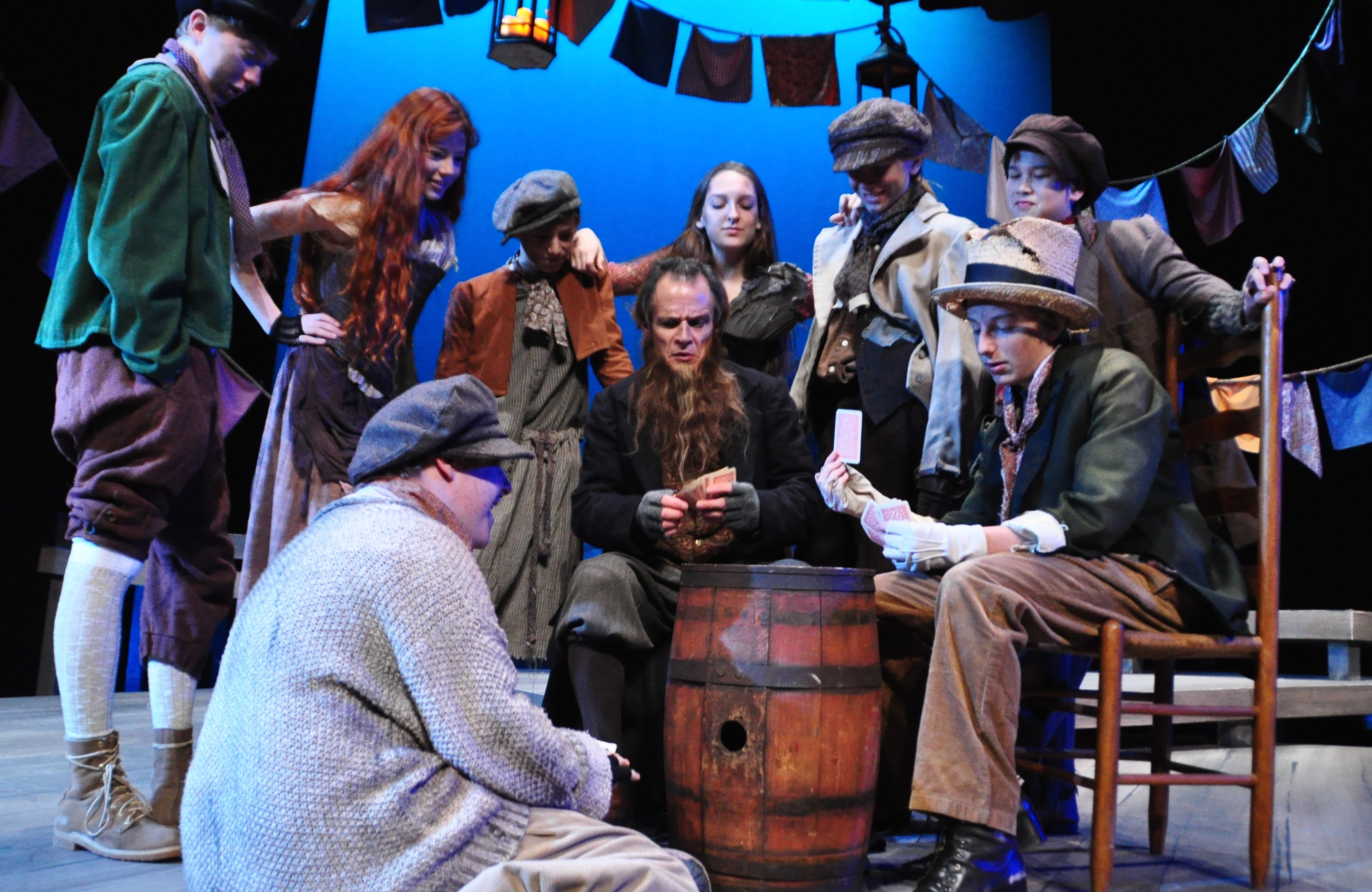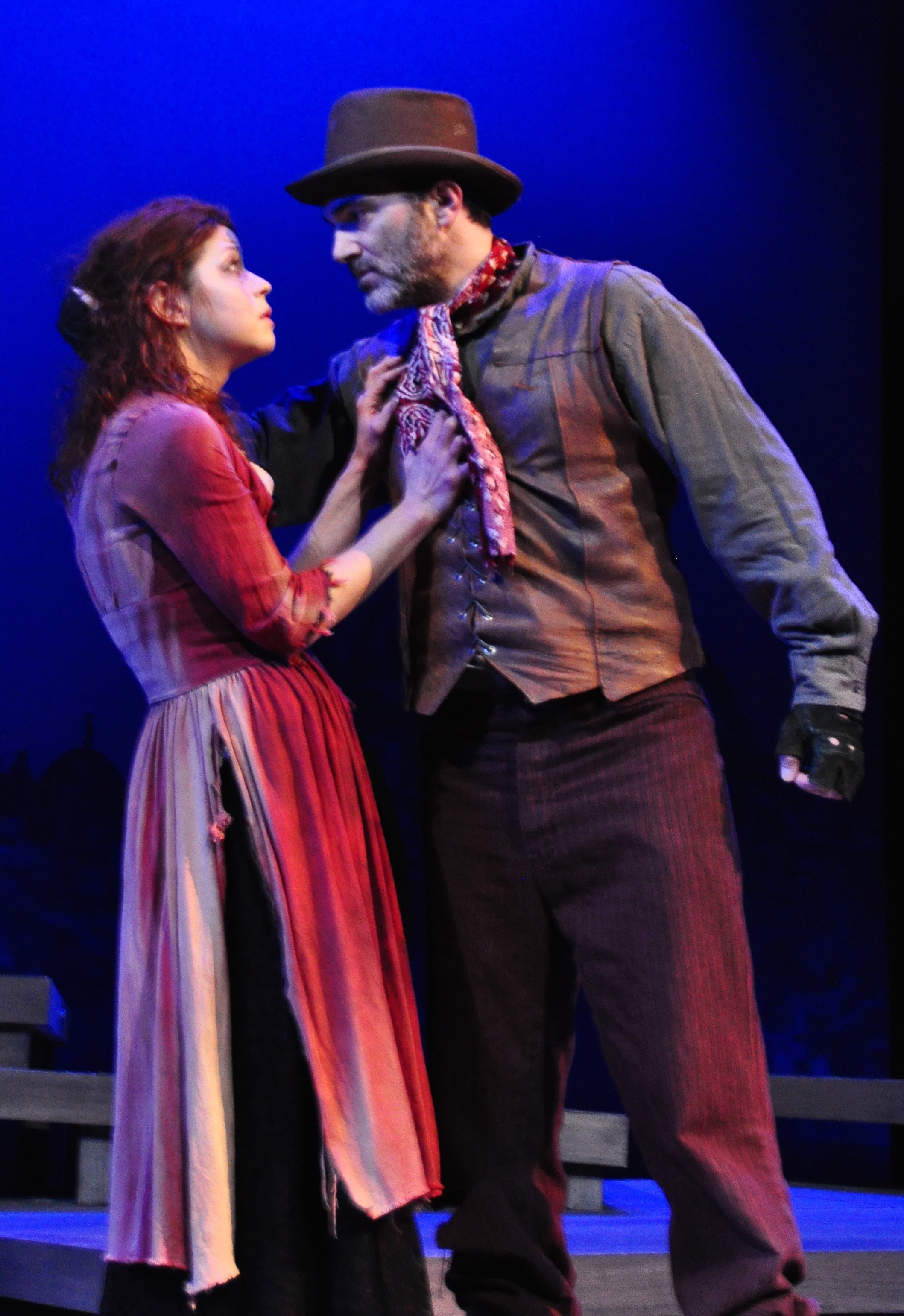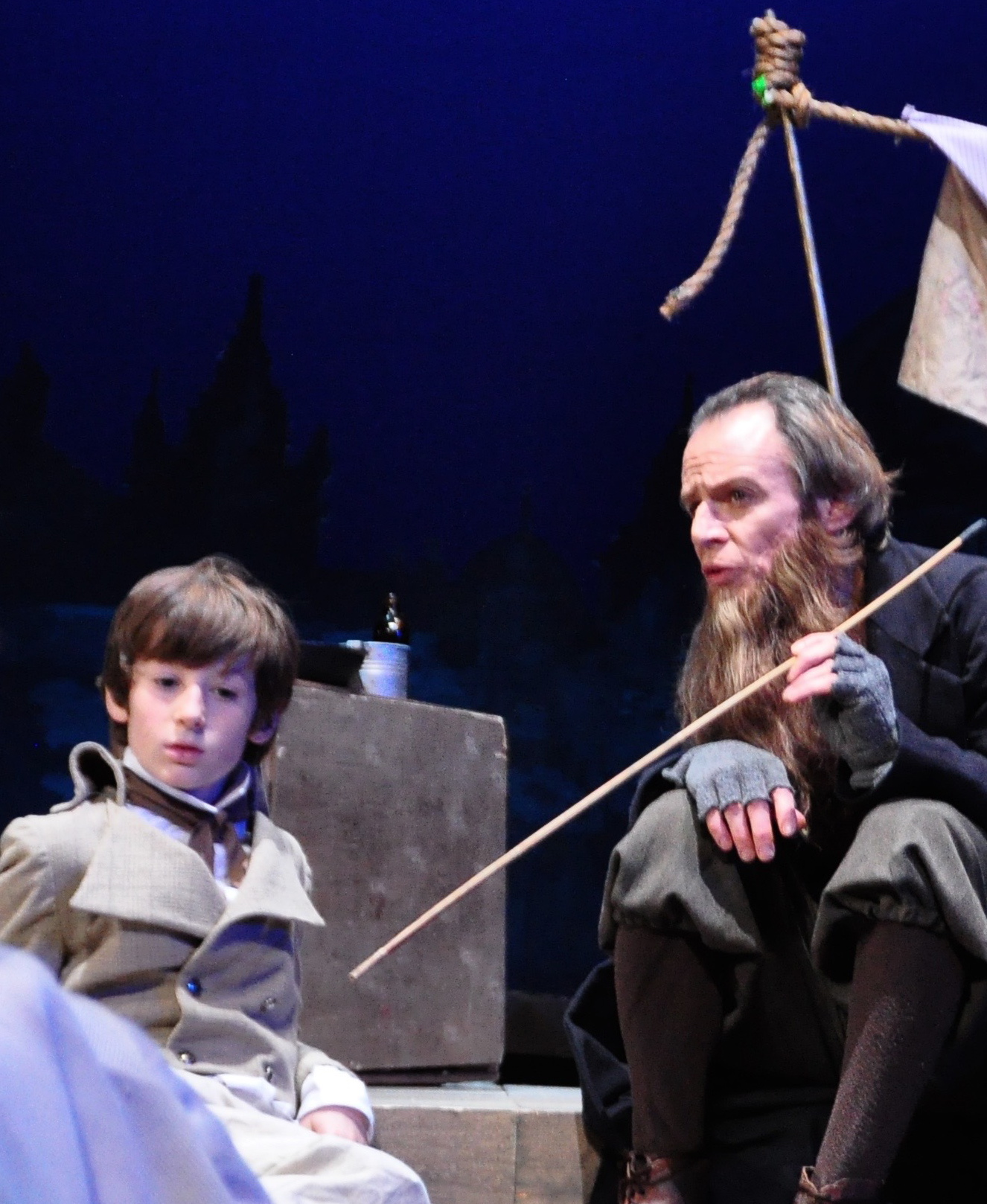PICT’s ‘Oliver Twist’ Offers a Different Kind of Holiday Punch

They’re playing with a full deck, but the game isn’t fair. Fagin (James FitzGerald, bearded) controls the rackets, and young folks like the Artful Dodger (Simon Colker, R, in the torn hat) are his minions.
Conventional wisdom says we can get all the Charles Dickens we need for the holidays by seeing a stage or film version of A Christmas Carol. But why be conventional? PICT Classic Theatre’s Oliver Twist—adapted from an earlier, grittier Dickens novel—is a play I would recommend whether you love A Christmas Carol or think the Scrooge tale is supernatural humbug.
Oliver Twist does not depict a bad guy magically turning good overnight. It puts badness on display in many cruel forms, and shows what can be required to make goodness break through. PICT’s Twist also is different from, and truer to the novel than, the stage musical Oliver! It’s a straight play, without song-and-dance numbers to brighten things up. And though it won’t send the crowd home humming “You’ve Got to Pick a Pocket or Two,” the play does have stirring scenes that stick in the mind’s eye and ear—along with some nice touches of sardonic humor.
This version of the story is one that premiered at Dublin’s Gate Theatre in 2000. Alan Stanford, who’s now the head of PICT, wrote the adaptation. He is directing the current production, which does justice to a story about a world where injustice often reigned.
Journey into the Fog
Oliver Twist was first published in monthly magazine installments from 1837 to 1839, during a time when England’s burgeoning economic power led to a nightmare society for many caught in the gears. Dickens used the episodes to illustrate the various depravities lower-class youth might face.
Young Oliver is raised in a brutal workhouse for orphans, then sent out to an equally harsh apprenticeship. Fleeing that gig, he is hijacked into a gang of child pickpockets, and this becomes the meat of the story. Oliver enters a bizarre netherworld of criminal scheming and double-dealing, from which he is finally rescued not by the authorities—the system is part of the problem—but by a kind gentleman, plus another brave soul or two, who are willing to reach out personally.
Dickens’ saga is complex. The adaptation trims a few sub-plots and whittles out some characters, honing it to two and half hours that run well. Some of the novel’s best dialogue is kept, including the famous line “the law is a ass.” Good new stuff has been added, both in Stanford’s script and by the child actors who, says Stanford, invented a lot of their own interactions and stage business.

The language of love: Nancy (Karen Baum) and Bill Sikes (Tony Bingham) strike a pose that says “dysfunctional relationship.”
But there’s more than sharp chatter at work here. The play is visually stunning. It opens with a death scene (the first of several) staged at night in eerie fog. The criminal action proceeds under a looming silhouette of the old London skyline as a backdrop. And the actors, too, are a sight to behold. Through a mixture of fortunate casting and artfully coordinated movement (done smoothly even on the preview night I went), they create flashes of human imagery that are literally moving, regardless of the words they speak.
Actors Look Good Being Bad
One key character is the adult criminal Bill Sikes. Tony Bingham plays the role, and he portrays a captivatingly terrifying Sikes just by the way he looks—smoldering with lust, simmering with resentment about to burst. To get the most from this play, you can’t just sit there digesting the story line; you’ve got to watch it.
Also delivering a remarkable performance is Jordon Ross Weinhold. In a comical courtroom scene, he plays the ditzy magistrate, punching up his lines of babbling nonsense with wacky mannerisms that are like Groucho on speed.
A comical turn that also merits close watching is a love scene early in the play. The master and chief matron of the orphanage (David Cabot and Bridget Connors) really shouldn’t be venturing furtively into kissy-face and huggy-bear, but they do, and I loved how they did it.
Actors with major, serious parts include: James FitzGerald as Fagin, the elderly arch-criminal who runs the gang of kids; Karen Baum—very memorably—as Nancy, a young woman who has “graduated” from Fagin’s youth corps into a thrilling life as a prostitute and Bill Sikes’ lover; Martin Giles as Mr. Brownlow, the good gentleman who rescues Oliver from Fagin and company; and Will Sendera, a sixth-grader at Pittsburgh CAPA, as Oliver.
But heck, one could go on mentioning the whole cast, kids and adults alike. I want to add that PICT’s Oliver Twist does have limitations as a work of drama. They stem mainly from the nature of Dickens’ original tale.
Strengths and Weaknesses
On the one hand, Charles Dickens was a great storyteller. He knew how to build suspense and create scenes tingling with touch-and-go conflict, and Stanford’s play preserves these qualities. I went with a friend who did not know the story, and he told me that the twists and turns gave him quite a ride. I’d say that even if you are familiar with the plot, the edge-of-the-seat factor should be high.
The low factor is psychological nuance. In this story especially, Dickens’ characters are mostly one-dimensional. Brownlow, Oliver’s rescuer, is a resolutely good guy. The wickedly selfish baddies persist in their wickedness. (“You’re a devious bastard, Fagin,” Nancy says at one point, to which Fagin replies “Thank you, my dear.”) There are upper-class characters who live with social blinders on, and they pretty much stay locked into their uppity views.
To some extent, this one-dimensionality isn’t a flaw. A lot of people in the real world behave like the people in Oliver Twist. Putting them together in one story makes for a vivid morality play. And though it may be trite to use the word “relevant,” the tensions and tragedies depicted in this nearly 200-year-old story are still very much with us.
A quality that gets lost, however, is the chance to see characters wrestling with conflicting aspects of themselves, and emerging either stronger or worse for it. Aside from the part of Nancy—again, played memorably by Karen Baum—there’s not much of that.
Bill Sikes so enthralled me that I’d have loved to see more about what makes his time bomb tick. And OIiver, despite being the title character, actually isn’t given much to do except remain steadfastly bright-eyed and honest through all of the buffeting he receives. He’s mainly a focal point for the machinations of the adults, as opposed to an active protagonist.
But young Sendera plays the role as it needs to be played. The rest of the gang does the same with their roles. And if you keep in mind that this is Dickens, not Chekhov or Dostoevsky, I’m betting you’ll find a lot to like in Oliver Twist.
Closing Credits and Ticket Info
Dickens’ Oliver Twist, adapted and directed by Alan Stanford, runs through Dec. 19 at PICT Classic Theatre, in the Charity Randall Theatre inside the Stephen Foster Memorial, 4301 Forbes Ave., Oakland. I don’t usually mention the tech team on a play, but Johnmichael Bohach (scenic design), Keith A. Truax (lighting), Joan Markert (costumes), and others on the crew deserve a call-out for the jobs they’ve done with this one. For showtimes and tickets visit PICT or call 412-561-6000.
Photos by Suellen Fitzsimmons.
Mike Vargo, a Pittsburgh-based writer and editor, covers theater for Entertainment Central.
Share on Social Media
Follow Entertainment Central
Latest Stories
Sign up for the EC Newsletter








